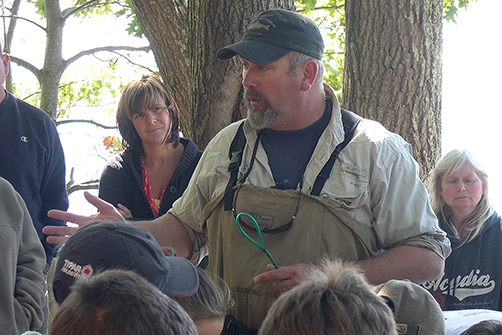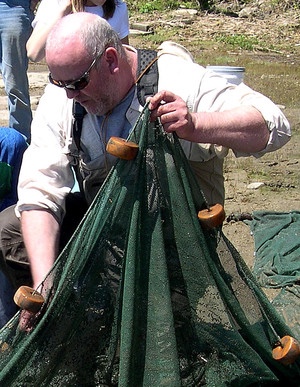 |
|||||||||||||||

American Shad
April 13, 2022 - 7:00pm
Nate Gray, Fisheries Biologist,
Maine Department of Marine Resources
Image of Nate Gray courtesy of Ed Friedman, Friends of Merrymeeting Bay
Friends of Merrymeeting Bay’s (FOMB) seventh presentation of their 25th annual Winter Speaker Series, American Shad, features Nate Gray, Fisheries Biologist with the Maine Department of Marine Resources. FOMB’s Winter Speaker Series presentations are again being held via Zoom and are accessible via hyperlink at the top of the FOMB web page: www.fomb.org. This event takes place Wednesday, April 13th, at 7 pm.
American Shad Alosa sapidissima (the species name means “most delicious”) are anadromous fish requiring connectivity between marine and freshwater habitats to complete their lifecycle. They are dark blue to green above with paler sides and a silvery underbelly. Shad are the largest members of the true herring family and can grow to 30 inches in length and weigh over 9 lbs. This species is highly sought after as a sportfish because of their feisty nature and their ability to leap. Almost every major river along the Atlantic seaboard historically supported a spawning population of American shad but their numbers continue to drop.
Historically, populations of American shad supported recreational, subsistence, and commercial fisheries in the Atlantic coastal waters of North America with annual landings ranging in the millions of pounds. Overfishing, pollution, and habitat loss resulting from dams, restricted passage, and human development have reduced populations and subsequently, total landings. Many state and federal agencies have prioritized the management of American shad by supporting research and monitoring programs aimed at conserving and restoring populations.
Author John McPhee wrote an excellent book about shad entitled The Founding Fish. The title alludes in part to a storied (as he makes clear) exceptionally early and prolific run of shad on the Schuylkill River at Valley Forge during the winter of 1777-1778. This supposed sea-run bounty was said to have brought the Continental Army much needed relief in the form of oily protein, thus making possible Washington’s victories that spring. According to the National Park Service, this may in more ways than one, be a bit of a fish story, in that barrels of shad, if delivered at all, were actually brought in from the Potomac because the British had used nets to block seasonal spring fish runs, downstream of Washington’s encampment. No matter their origin or whether they made it to Valley Forge, shad still played an important historical and perhaps pivotal role in the founding of our country.
While many of our waters are cleaner, prolific dams still threaten anadromous fish populations by severing the migration of populations travelling from the ocean to and from freshwater spawning habitats. Dams impose migration delays and can exert other negative effects on survival and fitness. The construction of fishways at dams is one approach used to mitigate obstructions to migrating fish but it is a poor substitute for unimpaired passage, particularly when it comes to a nervous species like shad, reticent to enter fishway structures.
Nate Gray is project leader for the Kennebec Hydropower Developers Group (KHDG) program of the Maine Department of Marine Resources, Bureau of Sea Run Fisheries and Habitat (BSRFH). He is also on the Board of FOMB. Nate has worked extensively on the Kennebec River and its tributaries since 1992 and been
involved in virtually all aspects of the restoration program. He witnessed the removal of Edwards Dam in Augusta in 1999 and has seen the populations of river herring (alewives and blueback herring) rise from a hundred thousand to over three million with the installation of multiple fish passages and the opening of thousands of acres of historical habitat in the Kennebec drainage. Nate has also worked extensively on American shad restoration in the Kennebec River and was actively involved in the Waldoboro Shad Hatchery from 1992-2007.
FOMB hosts their Winter Speaker Series October-May, the second Wednesday of each month. Due to the Covid 19 pandemic, the series continues via Zoom. The FOMB May 11th presentation: To Bee or Not to Bee features the Piti Theatre Company This event takes place at 7:00 pm with the Zoom access link available at www.fomb.org a week or so prior to the presentation.Speaker Series presentations are free, open to the public. Visit www.fomb.org to see speaker biographies, full event schedules, video recordings of past presentations, become a member, and learn more about how you can help protect beautiful Merrymeeting Bay and the Gulf of Maine.
For more information contact FOMB at 207-666-3372 or edfomb@comcast.net.
Watercolors by
Sarah Stapler
Sarah Stapler

